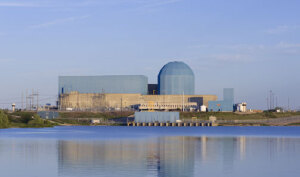
Clinton Power Station (Credit: Exelon)
GE Hitachi Nuclear Energy said Monday it was looking into a process at Clinton Power Station, a nuclear power plant in the Midwest, that could one day provide half of the country's molybdenum-99 needs.
The Wilmington, N.C. company said it was working with Exelon, which runs the plant, to conduct a feasibility study on using the plant to produce the sought-after medical isotope.
The plant, located 6 miles east of Clinton, Ill., currently powers 1 million homes and also produces cobalt-60, an isotope used in radiotherapy.



Ad Statistics
Times Displayed: 370263
Times Visited: 8733 Quality remanufactured Certified Centrifuges at Great prices! Fully warranted and backed by a company you can trust! Call or click for a free quote today! www.Centrifugestore.com 800-457-7576
Molybdenum-99 is the parent isotope of technetium-99m, used in about 85 percent of nuclear medicine studies, according to GE Hitachi.
Recently, a series of Mo-99 shortages have rocked the nuclear medicine industry. Doctors rely on a handful of aging reactors -- some nearly half a century old -- to produce the isotope. And last year, two of the main isotope-producing workhorses, a plant in the Netherlands and one in Canada, were both out of commission for simultaneous repairs, leading to widespread shortages.
Also, the U.S. government has been pushing for ways to shore up domestic supplies without using highly enriched uranium, which can be used to make weapons.
GE Hitachi thinks a process they're working on can help with both goals: increasing our supply of the isotope, without relying on weaponizable materials. The company still has patent applications pending so isn't fully discussing the method right now, but it involves what's known as activation molybdenum.
Currently, most moly-99 is produced by fissioning highly enriched uranium targets. The HEU targets are placed in a nuclear reactor, where they're exposed to neutrons. The targets then split off into fission fragments, 6 percent of which are usable molybdenum-99.
In the new process, a metal, molybdenum-98, is placed in the reactor, where it absorbs neutrons and becomes molybdenum-99. This results in less waste and eliminates the need for HEU.
A similar process has been tested before, and was used by GE to make commercial moly in a test reactor in California in the 1960s.
However, because the isotope has a short half-life -- only 66 hours -- the company also wants to set up a system involving transport by specialized licensed shipping containers. These would ship the newly minted moly to processing facilities, which would then the deliver the Mo-99 to nuclear pharmacies across the country.
GE Hitachi said they've also struck preliminary deals with NuView Life Sciences in Denton, Texas and NorthStar Medical Radioisotopes in Beloit, Wisc., to act as possible processors of the isotopes.
"GEH's new isotope production technology could potentially meet approximately 50 percent of the United States' projected supply needs of this critical isotope, ensuring consistent patient access to vital medical diagnostic procedures," Kevin Walsh, senior vice president, nuclear fuel cycle for GE Hitachi, said in a statement.
If the feasibility studies work, GE Hitachi will likely make modifications to the Clinton power plant during its next planned outage, in 2013. Production of the moly could then begin, at the earliest, in 2014.
GE has, it turns out, worked with the plant before: it designed the 24-year-old Clinton Power Station's boiling water reactor.

